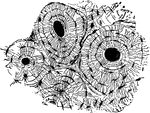Clipart tagged: ‘"spongy bone"’

Bone Structure
If we divide any of the long bones longitudinally, we find two kinds of structure, the hard or compact,…

Bisection of the Humerus
The humerus bisected lengthwise. Labels: a, marrow-cavity; b, hard bone; c, spongy bone; d, articular…
Longitudinal Section of Humerus
Longitudinal section of humerus showing relation of compact and spongy bone.
Thigh Bone
The thigh bone cut through the middle. Labels: b, hard bone; h, d, spongy bone; ma, marrow.

Inferior Turbinated Bone
The inner surface (A) and outer surface (B) of the right inferior turbinated bone.